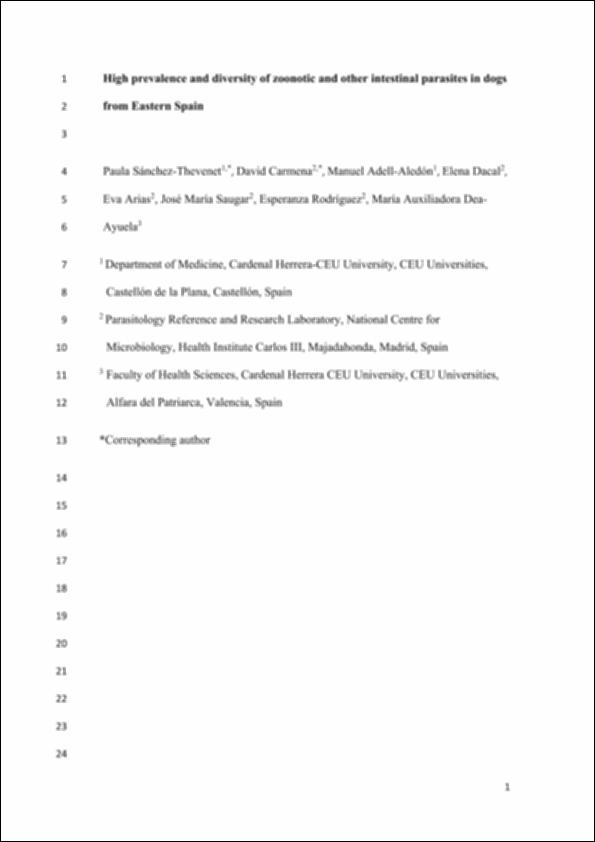Please use this identifier to cite or link to this item:
http://hdl.handle.net/10637/13018High prevalence and diversity of zoonotic and other intestinal parasites in dogs from Eastern Spain
| Title: | High prevalence and diversity of zoonotic and other intestinal parasites in dogs from Eastern Spain |
| Authors : | Sánchez Thevenet, Paula Carmena Jiménez, David Antón Adell Aledón, Manuel Dacal Picazo, Elena Arias Bravo, Eva Saugar Cruz, José María Rodríguez de las Parras, Esperanza Dea Ayuela, María Auxiliadora |
| Keywords: | Dogs - Communicable diseases.; Perros - Parásitos.; Intestinos - Parásitos.; Zoonosis.; Perros - Enfermedades infecciosas.; Intestines - Parasites.; Zoonoses.; Dogs - Parasites. |
| Publisher: | Mary Ann Liebert. |
| Citation: | Sanchez-Thevenet, P., Carmena, D., Adell-Aledón, M., Dacal, E., Arias, E., Saugar, J.M. et al. (2019). High prevalence and diversity of zoonotic and other intestinal parasites in dogs from Eastern Spain. Vector-Borne and Zoonotic Diseases, vol. 19, i. 12 (dec.), pp. 915-922. DOI: http://doi.org/10.1089/vbz.2019.2468 |
| Abstract: | The diversity and frequency of enteric parasites in dog populations in the Castellón province (Eastern Spain) was assessed by means of a prospective cross sectional epidemiological survey. A total of 263 canine faecal samples were collected between July 2014 and July 2016. Detection of intestinal parasites was conducted by routine coprological methods. In addition, identification of Giardia duodenalis and Cryptosporidium spp. was carried out by direct immunofluorescence microscopy, whereas the presence of Strongyloides spp. was assessed by real-time PCR in a selected number of specimens. Based on conventional and/or immunofluorescence microscopy examination, 65.8% (95% CI: 59.7%‒71.5%) of the investigated dogs were found infected by at least one gastrointestinal parasite. Giardia duodenalis (35.4%) and members of the family Ancylostomatidae (27.0%) were the most prevalent protozoan and helminth parasites found, respectively. Other pathogens potentially infective to human included Toxocara canis (8.0%), Cryptosporidium spp. (6.8%), and Strongyloides spp. (1.1%). Frequency of occurrence of helminthic, but not protozoan, enteroparasites was geographical origin-dependent (P = 0.02), with dogs living in coastal areas presenting higher infection rates than those living in inland regions. Similarly, rural dogs were significantly more infected than urban dogs (P < 0.001). Our results revealed that zoonotic agents were common in dogs from the Castellón province. Animals from rural areas and sheltered dogs were particularly at risk of these infections. |
| Description: | Este artículo se encuentra disponible en la siguiente URL: https://www.liebertpub.com/doi/10.1089/vbz.2019.2468 Nota de Fondos: Esta versión preprint del artículo se encuentra a texto completo en el CEU Repositorio Institucional. This is the pre-peer reviewed version of the following article: Sanchez-Thevenet, P., Carmena, D., Adell, M., Dacal, E., Arias, E, Saugar, J.M. et al. (2019). High prevalence and diversity of zoonotic and other intestinal parasites in dogs from Eastern Spain. Vector-Borne and Zoonotic Diseases, vol. 19, i. 12 (01 dec.), pp. 915-922, which has been published in final form at http://doi.org/10.1089/vbz.2019.2468 Este es el pre-print del siguiente artículo: Sanchez-Thevenet, P., Carmena, D., Adell, M., Dacal, E., Arias, E, Saugar, J.M. et al. (2019). High prevalence and diversity of zoonotic and other intestinal parasites in dogs from Eastern Spain. Vector-Borne and Zoonotic Diseases, vol. 19, n. 12 (01 dic.), pp. 915-922, que se ha publicado de forma definitiva en http://doi.org/10.1089/vbz.2019.2468 |
| URI: | http://hdl.handle.net/10637/13018 |
| Rights : | http://creativecommons.org/licenses/by-nc-nd/4.0/deed.es |
| ISSN: | 1530-3667 1557-7759 (Electrónico) |
| Issue Date: | 1-Dec-2019 |
| Center : | Universidad Cardenal Herrera-CEU |
| Appears in Collections: | Dpto. Farmacia |
Items in DSpace are protected by copyright, with all rights reserved, unless otherwise indicated.


